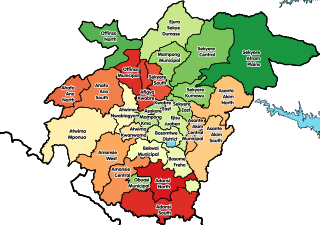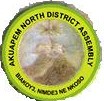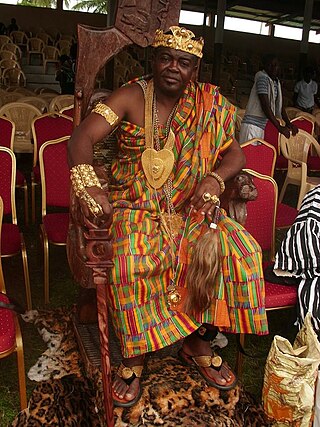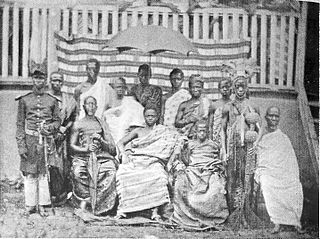Related Research Articles

Osei Tutu II is the 16th Asantehene, enstooled on 26 April 1999. By name, Otumfuo Osei Tutu II is in direct succession to the 17th-century founder of the Ashanti Empire, Otumfuo Osei Tutu I. He is also the Chancellor of the Kwame Nkrumah University of Science and Technology. Otumfuo Osei Tutu II is the Grand Patron of the Grand Lodge of Ghana and the Sword Bearer of the United Grand Lodge of England.
The Akan people are a Kwa group living primarily in present-day Ghana and in parts of Ivory Coast and Togo in West Africa. The Akan speak dialects within the Central Tano branch of the Potou–Tano subfamily of the Niger–Congo family. Subgroups of the Akan people include: the Agona, Akuapem, Akwamu, Akyem, Anyi, Ashanti, Baoulé, Bono, Chakosi, Fante, Kwahu, Sefwi, Wassa, Ahanta, and Nzema, among others. The Akan subgroups all have cultural attributes in common; most notably the tracing of matrilineal descent in the inheritance of property, and for succession to high political office.

Offinso Municipal District is one of the forty-three districts in Ashanti Region, Ghana. Originally created as an ordinary district assembly in 1988 when it was known as Offinso District, which it was created from the former Offinso District Council; until the northern part of the district was later split off to create Offinso North District on 29 February 2008; while the remaining part was elevated to municipal district assembly status on the same year to become Offinso Municipal District. The municipality is located in the northern part of Ashanti Region and has Offinso as its capital town.

Akropong is a town in South Ghana and is the capital of the Akuapim North District, a district in the Eastern Region of South Ghana. This town is known for producing snails and palm oil. Akropong has a 2013 settlement population of 13,785 people.
In many parts of West Africa, there is an old chieftaincy tradition, and the Akan people have developed their own hierarchy, which exists alongside the democratic structure of the country. The Akan word for the ruler or one of his various courtiers is "Nana". In colonial times, Europeans translated it as "chief", but that is not an exact equivalent. Other sources speak of "kings", which is also not entirely correct, especially in the case of the said courtiers. The term "chief" has become common even among modern Ghanaians, though it would be more correct to use the expression "Nana" without translation wherever possible.

Otumfuo Opoku Ware II was the 15th Asantehene. He succeeded his uncle Osei Tutu Agyeman Prempeh II on 27 July 1970. He ruled for 29 years until his death in February 1999. He was succeeded by Otumfuo Nana Osei Tutu II.
In several Akan nations of Ghana, the Omanhene is the title of the supreme traditional ruler ('king') in a region or a larger town. The omanhene is the central figure and institution of the nation. Officially, he has no function in the current Ghanaian political setup, but, has enormous influence on the people that constitute it. Today 'Hene' can be found in titles of other rulers in Ghanaian nations. For example, the chief of the Dagomba in the north of Ghana is known as the 'Dagombahene'.
There are four orders in Ghana: Order of the Star of Ghana, Order of the Volta, Medal for Gallantry and Grand Medal.
Konongo Odumase Senior High School is a coeducational second-cycle institution at Konongo-Odumase in the Asante Akim Central District of the Ashanti Region of Ghana.

Queen mother is a term used to describe certain female traditional rulers in African cultures. Though there is no general description of a "queen mother", as their roles have varied by society, political context, and culture, they generally play an important role in local government and "wield social power and influence."

Togbe Osei III is the Togbe of Godenu.

Nana Amoako Atta I,, was the paramount chief of Akyem Abuakwa in nineteenth century southern Ghana. Locally, his position is known as the Okyehene or Omanhene. He ruled the traditional kingdom from July 1866 to 1880 and from 1885 to 1887. After the Sagrenti War of 1874, the British declared Akyem Abuakwa a colonial possession, legally called a ‘protectorate’, as part of the Gold Coast. This development led to a clash between the old traditional Akan culture and the imposition of the new Western Christian political order.
Nana Dokua was the queen mother of Akyem Abuakwa. She was the one who welcomed the King of the Dwabens called Nana Kwaku Boateng and his army. A civil war broke out between the Ashantis and the Dwabens in 1832, six years after the battle of Akatamansu. In 1824, during her regime, she also provided refuge for the Kotokus who had also assisted Abuakwa in some wars against the Ashantis. During her reign, part of the Juabens revolted against the Ashantis. Nana Kwaku Boateng was the leader of the rebels who was their chief. They were forced to leave Juaben in Ashanti for the south.
Nana Obiri Yeboa was the Kumasehene during his era and the occupant of the Aban Dwa Stool. He reigned from 1660 to 1680. He was succeeded by Nana Osei Tutu as the chief of Kwaman state which was later known as Kumasi state. He was the uncle of Osei Tutu. Nana Obiri Yeboa's uncle was Nana Oti Akenten.
Yaa Asantewaa Festival is an annual festival celebrated by the chiefs and peoples of the Ejisu Traditional Area in the Ashanti Region of Ghana. It is usually celebrated in the month of August.
Oblempong Nii Kojo Ababio V was a Ghanaian dental surgeon pioneer who also served as the Jamestown Maŋtsɛ and President of the Ngleshie Alata Traditional Council. He was popularly known as Dentist Cofie.
Nana Kwabena Wiafe also known as Nana Kwabena Wiafe Ababio or, in private life, Kwabena Sanwo Ansah, was a traditional ruler and Omanhene of Offinso Traditional Area. He is known to be the first Offinso royal to be enstooled twice in Offinso history. He reigned from 1935 to 1945 and from 1959 to 1966.
HRH Oheneba Nana Kwame Obeng II is the recognized traditional sovereign leader of the Sefwi Obeng-Mim stool lands and Chief of the Royal House of Sefwi Obeng-Mim in the Republic of Ghana. He is the ruler, and Toufohene of the dynastic orders, of Sefwi Obeng-Mim stool lands, a subnational kingdom in the Sefwi Wiawso Traditional Territory of Ghana. He was appointed by the Paramount Chief as a Divisional Chief, overseeing other local chieftaincies.
References
- ↑ "The Role Of Chieftaincy In Ghana". www.ghanaweb.com. 30 November 2001. Retrieved 9 June 2019.
- ↑ "Constitution of the Republic of Ghana". www.ghanaweb.com. Archived from the original on 20 April 2019. Retrieved 9 June 2019.
- ↑ "Chieftaincy Act - GhanaLegal - Legal Portal for Ghana". laws.ghanalegal.com. Archived from the original on 10 April 2019. Retrieved 9 June 2019.
- ↑ "Chieftaincy Act - GhanaLegal - Legal Portal for Ghana". laws.ghanalegal.com. Archived from the original on 6 February 2017. Retrieved 9 June 2019.
- ↑ Modey, Emmanuel (13 August 2013). "Nana Letsabi, legitimate Paramount Chief of Santrokofi". ModernGhana . Retrieved 19 May 2021.
- ↑ "Manhyia Palace - ghanagrio.com". www.ghanagrio.com. Archived from the original on 6 June 2019. Retrieved 9 June 2019.
- 1 2 Aidoo, Kwame (2 July 2018). "Meet the 'White Chiefs' of Ghana". Culture Trip. Retrieved 9 June 2019.
- ↑ "The Royal Order of the Lion of Godenu". royalgodenu.org. Retrieved 9 June 2019.
- 1 2 "Royal Order of the Golden Fire Dog". Official Website of the Royal house of Sefwi Obeng-Mim. Archived from the original on 6 June 2019. Retrieved 9 June 2019.
- ↑ Listed as a recognized Dynastic Order by The Augustan Society
- ↑ "The Royal Order of the Golden Leopard – An Order of the Kingdom of Ashanti Akyem Hwidiem" . Retrieved 30 March 2023.
- ↑ "Kingdom of Papagya – A Subnational Kingdom of Ghana" . Retrieved 30 March 2023.
- ↑ Listed as a Royal Patron of The Heraldry Society of Africa
- ↑ "Conheça Ashanti Akyem Hwidiem". 3 March 2022.
- ↑ "Kingdom of Papagya – A Subnational Kingdom of Ghana" . Retrieved 30 March 2023.
- ↑ https://www.new-sawereso.org/about